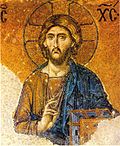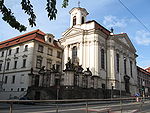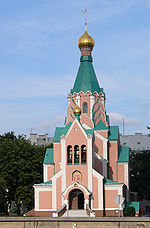- Czech and Slovak Orthodox Church
-
Orthodox Church of the Czech Lands and Slovakia 
Founder Ss. Cyril and Methodius Independence 1951, 1998 Recognition Autocephaly recognised in 1951 by the Russian Orthodox Church and in 1998 by the Ecumenical Patriarchate of Constantinople. Primate Metr. Christopher Headquarters Prague, Czech Republic
Prešov, SlovakiaTerritory Czech Republic and Slovakia Possessions — Language Church Slavonic Adherents 100,000[1] Website Official website in the Czech Republic (in Czech) Official website in Slovakia (in Slovak)
Part of a series on Eastern Christianity 
History Orthodox Church History
Specific regions:
Byzantine Empire
Ecumenical council
Christianization of Bulgaria
Christianization of Kievan Rus'
East-West Schism
Asian Christianity
Coptic Egypt · UkraineTraditions Orthodox Church
Others:
Oriental Orthodoxy
Ethiopian Tewahedo Church
Coptic Church
Church of the East
Eastern Catholic Churches
Syriac ChristianityLiturgy and worship Sign of the cross
Divine Liturgy
Iconography
Asceticism
OmophorionTheology Hesychasm · Icon
Apophaticism
Filioque clause
Miaphysitism
Monophysitism
Diophysitism
Nestorianism
Theosis · Theoria
Phronema · Philokalia
Praxis · Theotokos
Hypostasis · Ousia
Essence vs. Energies
MetousiosisThe Orthodox Church of the Czech Lands and Slovakia is a self-governing body of the Eastern Orthodox Church that territorially covers the countries of the Czech Republic and Slovakia. The primate is His Beatitude, Metropolitan Christopher of Prague and the Czech Lands and Slovakia, who was elected on May 2, 2006.
Contents
History
 Orthodox church of Saints Cyril and Methodius in Prague
Orthodox church of Saints Cyril and Methodius in Prague
The Church of the Czech Lands and Slovakia presents both an ancient history as well as a very modern history. The present day church occupies the land of Moravia, where the brothers Ss. Cyril and Methodius began their mission to the Slavs, introducing the liturgical and canonical order of the Orthodox Church, translated into the Church Slavonic language. In doing this they developed the first Slavic alphabet. This mission was destroyed after Methodius died in 885, as Pope Stephen V of Rome forced all disciples of the brothers to leave the countryside which is now the Czech Republic. The Orthodox order survived in present day Slovakia due to its nearness and influence to Kievan Rus' until the union with Rome was instituted by the Viennese Court.
After the legal restraints to Orthodoxy were removed with the end of World War I, many people left the Roman Catholic Church. Many looked to the Serbian Orthodox Church as parts of the Serbian church had been within the pre-war union. Among those seeking the Orthodox church was a Roman Catholic priest, Matěj Pavlík, who had been interested in Orthodox Christianity for years. The Church of Serbia thus consented to consecrate Matěj Pavlík as a bishop of the Orthodox Church with the name Gorazd.
On September 25, 1921, Archimandrite Gorazd was consecrated Bishop of Moravia and Silesia at the Cathedral of the Holy Archangel Michael in Belgrade, Yugoslavia, by Patriarch Dimitri of Serbia. Bp. Gorazd (Pavlik) is considered to be in the succession from Archbishop Methodius of Moravia and bears the name of one of St. Methodius's disciples and successor, Bp. Gorazd.
As the Orthodox leader in the new nation of Czechoslovakia, Bp. Gorazd laid the foundations of the Orthodox Church throughout Bohemia, Moravia, and into Slovakia. In Bohemia, he oversaw the building of eleven churches and two chapels. He also published the essential books for the conduct of church services that were translated in the Czech language. He provided aid to those in Slovakia and Subcarpathian Rus' which then were part of Czechoslovakia, and who wanted to return to their ancestral Orthodox faith from the Unia. Thus, in the interbellum period, Bp. Gorazd built the small Czech church that during World War II would show how firmly it was connected to the Czech nation.
As Hitler and the Nazis swept through Europe, a harsh rule descended on each nation. Czechoslovakia was no different as it suffered under the rule of Hitler's heir apparent, Reichsprotector Reinhard Heydrich. After the May 27, 1942, assassination attack on Heydrich's car in Prague, Czech patriots took refuge in the crypt of the Ss. Cyril and Methodius Cathedral before continuing their escape. They were aided by senior church laymen, who kept Bp. Gorazd informed. However, their presence was discovered by the Nazis, and on June 18 the Nazis attacked their hiding place in the cathedral, forcing them to commit suicide. The Orthodox priests, laymen, and Bp. Gorazd were arrested and killed by firing squads on September 4, 1942.
In reprisal the Nazis forbade the church to operate in Bohemia and Moravia. Churches and chapels were closed, and a rounding up of Czechs was conducted, including the whole village of Lidice, whose inhabitants were either killed or sent to forced labor camps. For the Orthodox the whole church fell under the Nazi persecution and was decimated. A total of 256 Orthodox priests and laymen were executed, and church life came to a stop.
After World War II the Orthodox Church in Czechoslovakia began its recovery without its beloved bishop. On December 9, 1951, the Patriarch of Moscow granted autocephaly to the Orthodox Church of Czechoslovakia, though this action was not recognized by Constantinople, which regarded the Czechoslovakian church as being autonomous under its authority. The Patriarch of Constantinople later granted a tomos of autocephaly on August 27, 1998.
The martyrdom of Bp. Gorazd was recognized by the Serbian Orthodox Church on May 4, 1961, which glorified Gorazd as a New Martyr. Subsequently, on August 24, 1987, he was glorified at the Cathedral of St. Gorazd in Olomouc, Moravia.
Administration
After the Czech and Slovak Republics separated into independent republics in 1993, activity continued in each country as separate legal entities: in the Czech Republic as the Orthodox Church in the Czech Lands and in the Slovak Republic as the Orthodox Church in Slovakia, but canonical unity was maintained as the Orthodox Church of the Czech Lands and Slovakia. The church is now organized into four eparchies divided into two administrative centers: the Metropolitan Council for the Czech Republic resident in Prague and the Metropolitan Council for the Slovak Republic in Prešov. Under the Council of the Czech Lands (Prague) are the eparchies of Prague and Olomouc-Brno, while the eparchies of Prešov and Michalovce are under the Council of Slovakia (Prešov).
After the repose of His Beatitude, Metropolitan Dorotheus of Prague and All Czechoslovakia, Archbishop Nicholas of Prešov was elected the new metropolitan, and the church's primatial see was moved from Prague to Prešov. Metr. Nicholas reposed on January 30, 2006, and was replaced by Archbishop Christopher of Prague and the Czech Lands (elected May 2, 2006).
In the Czech Republic, there are 82 parishes, with 51 in Bohemia and 31 in Moravia and Silesia. In the Republic of Slovakia, there are 69 parishes in the eparchy of Prešov and 21 in the eparchy of Michalovce. The Orthodox Theological Faculty of the University of Prešov provides an education for future priests of combined Church. The faculty maintains a detached branch in Olomouc.
The Monastery of St. Procopius of Sazava is located in Most, and that of the Dormition in Vilemov.
Head of the Orthodox Church of the Czech Lands and Slovakia is Christopher of Prague (Radim Pulec), Metropolitan of Czech Lands and Slovakia (2006-).
Arcdioceses and Archbishops
- Archdiocese of Prague and Czech Lands : Christopher (Pulec) (2000-), Metropolitan of Czech Lands and Slovakia (2006-)
- Archdiocese of Prešov and Slovakia : John (Jan) Holonic (2006-)
- Archdiocese of Brno and Olomouc : Simeon (Radivoj) Jakovlevic (2006-)
- Archdiocese of Michalovce and Košice : George (Juraj) Stransky (2009-)
Titular Dioceses and Bishops
- Diocese of Komárno : Tichon Holossyi (2006-) vicar bishop of Prešov
- Diocese of Hodonín : Joakim (Romanus) Hrdý (2009-) vicar bishop of Brno and Olomouc
References
External links
- Official website in the Czech Republic (in Czech)
- Official website in Slovakia (in Slovak)
- Electronic edition of the magazine "Icon"
- Pages about the orthodox Church in the Czech Republic (in Czech)
- Overview of the Church (scroll down)
Autocephalous and Autonomous Churches of Eastern Orthodoxy Autocephalous Churches Four Ancient Patriarchates: Constantinople · Alexandria · Antioch · Jerusalem
Russia · Serbia · Romania · Bulgaria · Georgia · Cyprus · Greece · Poland · Albania · Czech Republic and Slovakia · America* · Macedonia*Autonomous Churches * Autocephaly or autonomy is not universally recognized.
** Semi-autonomous part of the Russian Orthodox Church whose autonomy is not universally recognized.Orthodox Christianity in Europe Sovereign
states- Albania
- Andorra
- Armenia
- Austria
- Azerbaijan
- Belarus
- Belgium
- Bosnia and Herzegovina
- Bulgaria
- Croatia
- Cyprus
- Czech Republic
- Denmark
- Estonia
- Finland
- France
- Georgia
- Germany
- Greece
- Hungary
- Iceland
- Ireland
- Italy
- Kazakhstan
- Latvia
- Liechtenstein
- Lithuania
- Luxembourg
- Macedonia
- Malta
- Moldova
- Monaco
- Montenegro
- Netherlands
- Norway
- Poland
- Portugal
- Romania
- Russia
- San Marino
- Serbia
- Slovakia
- Slovenia
- Spain
- Sweden
- Switzerland
- Turkey
- Ukraine
- United Kingdom
- (England
- Northern Ireland
- Scotland
- Wales)
States with limited
recognition- Abkhazia
- Kosovo
- Nagorno-Karabakh
- Northern Cyprus
- South Ossetia
- Transnistria
Dependencies
and other territories- Åland
- Faroe Islands
- Gibraltar
- Guernsey
- Jan Mayen
- Jersey
- Isle of Man
- Svalbard
Other entities Categories:- Eastern Orthodox church bodies and patriarchates
- Christianity in the Czech Republic
- Christianity in Slovakia
- Czech Republic–Slovakia relations
Wikimedia Foundation. 2010.

